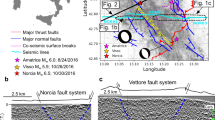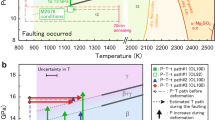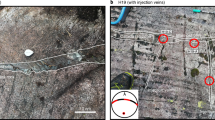Abstract
It has long been assumed that seismogenic faulting is confined to cool, brittle rocks, with a temperature upper limit of ∼600 °C (ref. 1). This thinking underpins our understanding of volcanic earthquakes, which are assumed to occur in cold rocks surrounding moving magma. However, the recent discovery of abundant brittle–ductile fault textures in silicic lavas2,3,4 has led to the counter-intuitive hypothesis that seismic events may be triggered by fracture and faulting within the erupting magma itself. This hypothesis is supported by recent observations of growing lava domes, where microearthquake swarms have coincided with the emplacement of gouge-covered lava spines5,6, leading to models of seismogenic stick-slip along shallow shear zones in the magma7. But can fracturing or faulting in high-temperature, eruptible magma really generate measurable seismic events? Here we deform high-temperature silica-rich magmas under simulated volcanic conditions in order to test the hypothesis that high-temperature magma fracture is seismogenic. The acoustic emissions recorded during experiments show that seismogenic rupture may occur in both crystal-rich and crystal-free silicic magmas at eruptive temperatures, extending the range of known conditions for seismogenic faulting.
This is a preview of subscription content, access via your institution
Access options
Subscribe to this journal
Receive 51 print issues and online access
$199.00 per year
only $3.90 per issue
Buy this article
- Purchase on Springer Link
- Instant access to full article PDF
Prices may be subject to local taxes which are calculated during checkout



Similar content being viewed by others
References
McKenzie, D., Jackson, J. & Priestley, K. Thermal structure of oceanic and continental lithosphere. Earth Planet. Sci. Lett. 233, 337–349 (2005)
Tuffen, H., Dingwell, D. B. & Pinkerton, H. Repeated fracture and healing of silicic magma generate flow banding and earthquakes? Geology 31, 1089–1092 (2003)
Tuffen, H. & Dingwell, D. B. Fault textures in volcanic conduits: Evidence for seismic trigger mechanisms during silicic eruptions. Bull. Volcanol. 67, 370–387 (2005)
Neuberg, J. et al. The trigger mechanism of low-frequency earthquakes on Montserrat. J. Volcanol. Geotherm. Res. 153, 37–50 (2006)
Cashman, K. V., Thornber, C. R. & Pallister, J. S. in A Volcano Rekindled: The First Year of Renewed Eruption at Mount St. Helens, 2004–2006 (eds Sherrod, D. R., Scott, W. E. & Stauffer, P. H.) Ch. 19 (USGS Professional Paper, US Geological Survey, Washington DC, in the press).
Nakada, S., Shimizu, H. & Ohta, K. Overview of the 1990–1995 eruption at Unzen volcano. J. Volcanol. Geotherm. Res. 89, 1–22 (1999)
Iverson, R. M. et al. Dynamics of seismogenic volcanic extrusion at Mount St Helens in 2004–2005. Nature 444, 439–443 (2006)
Chouet, B. Long-period volcano seismicity: Its source and use in eruption forecasting. Nature 380, 309–316 (1996)
Neuberg, J. Characteristics and causes of seismicity in andesite volcanoes. Phil. Trans. R. Soc. Lond. 358, 1533–1546 (2000)
Umakoshi, K. et al. Seismic activity associated with the growth of the lava dome at Unzen volcano (November 1993 - January 1994) — grouping of earthquakes on the basis of cross-correlations among their waveforms. Bull. Volcanol. Soc. Jpn 47, 43–55 (2002)
Smith, R., Kilburn, C. R. J. & Sammonds, P. R. Rock fracture as a precursor to lava dome eruptions at Mount St Helens from June 1980 to October 1986. Bull. Volcanol. 69, 681–693 (2007)
McNutt, S. R. Volcanic seismology. Annu. Rev. Earth Planet. Sci. 33, 461–491 (2005)
Goto, A. A new model for volcanic earthquake at Unzen volcano: Melt rupture model. Geophys. Res. Lett. 26, 2541–2544 (1999)
Voight, B. et al. Magma flow instability and cyclic activity at Soufriere Hills volcano, Montserrat, British West Indies. Science 283, 1138–1142 (1999)
Harrington, R. M. & Brodsky, E. E. Volcanic hybrid earthquakes that are brittle failure events. Geophys. Res. Lett. 34 L06308 10.1029/2006GL028714 (2007)
Gonnermann, H. M. & Manga, M. Explosive volcanism may not be an inevitable consequence of magma fragmentation. Nature 426, 432–435 (2003)
Rocchi, V., Sammonds, P. R. & Kilburn, C. R. J. Fracturing of Etnean and Vesuvian rocks at high temperatures and low pressures. J. Volcanol. Geotherm. Res. 132, 137–157 (2004)
Meredith, P. G. & Atkinson, B. K. Stress corrosion and acoustic emission during tensile crack propagation in Whin Sill dolerite and other basic rocks. Geophys. J. R. Astron. Soc. 75, 1–21 (1983)
Main, I. G. A damage mechanics model for power-law creep and earthquake aftershock and foreshock sequences. Geophys. J. Int. 142, 151–161 (2000)
Aki, K. Maximum likelihood estimate of b in the formula log N = a-bM and its confidence limits. Bull. Earthq. Res. Inst. Univ. Tokyo 43, 237–239 (1965)
Main, I. G., Sammonds, P. R. & Meredith, P. G. Application of a modified Griffith criterion to the evolution of fractal damage during compressional rock failure. Geophys. J. Int. 115, 367–380 (1993)
Read, A. D., Ayling, M. R., Meredith, P. G. & Murrell, S. A. F. Microcracking during triaxial deformation of porous rocks monitored by changes in rock physical properties, II. Pore volumometry and acoustic emission measurements on water saturated rocks. Tectonophysics 245, 223–235 (1995)
Hull, D. Fractography (Cambridge Univ. Press, Cambridge, UK, 1999)
Webb, S. L. & Dingwell, D. B. Non-Newtonian rheology of igneous melts at high stresses and strain rates: Experimental results for rhyolite, andesite, basalt and nephelinite. J. Geophys. Res. 95, 15695–15701 (1990)
Sammonds, P. R., Meredith, P. G. & Main, I. G. Role of pore fluids in the generation of seismic precursors to shear fracture. Nature 359, 228–230 (1992)
Sparks, R. S. J. et al. Control on the emplacement of the andesite lava dome of the Soufriere Hills volcano, Montserrat, by degassing-induced crystallization. Terra Nova 12, 14–20 (2000)
Aki, K. & Richards, P. G. Quantitative Seismology: Theory and Methods (Freeman and Co., San Francisco, California, 1980)
Burlini, L. et al. Seismicity preceding volcanic eruptions: New experimental insights. Geology 35, 183–186 (2007)
McGarr, A. Seismic moments and volume changes. J. Geophys. Res. 81, 1487–1494 (1976)
Uchida, N. & Sakai, T. Analysis of peculiar volcanic earthquakes at Satsuma-Iojima volcano. Earth Planets Space 54, 197–209 (2002)
Acknowledgements
We are grateful to J. Bowles, S. Boon and N. Hughes for technical assistance with the experiments, C. Kilburn and H. Pinkerton for discussions and W. Hirt for help during fieldwork on Mt Shasta. This research was supported by the UK Natural Environment Research Council and the Leverhulme Trust (H.T.).
Author Contributions H.T. provided the initial idea, carried out deformation experiments on obsidian, analysed data and co-wrote the paper. R.S. carried out deformation experiments on andesite, analysed data and co-wrote the paper. P.R.S. co-wrote the paper and assisted with the experimental programme.
Author information
Authors and Affiliations
Corresponding author
Supplementary information
Supplementary information
The file contains Supplementary Data, Supplementary Tables 1-6 and Supplementary Figures 1-9 with Legends. (PDF 304 kb)
Rights and permissions
About this article
Cite this article
Tuffen, H., Smith, R. & Sammonds, P. Evidence for seismogenic fracture of silicic magma. Nature 453, 511–514 (2008). https://doi.org/10.1038/nature06989
Received:
Accepted:
Issue Date:
DOI: https://doi.org/10.1038/nature06989
This article is cited by
-
Silicic conduits as supersized tuffisites: Clastogenic influences on shifting eruption styles at Cordón Caulle volcano (Chile)
Bulletin of Volcanology (2021)
-
Low-Amplitude Wave Propagation and Attenuation Through Damaged Rock and a Classification Scheme for Rock Fracturing Degree
Rock Mechanics and Rock Engineering (2020)
-
Decrypting silicic magma/plug fragmentation at Azufral crater lake, Northern Andes: insights from fine to extremely fine ash morpho-chemistry
Bulletin of Volcanology (2020)
-
Fingerprint of silicic magma degassing visualised through chlorine microscopy
Scientific Reports (2019)
-
The cause of the 2011 Hawthorne (Nevada) earthquake swarm constrained by seismic and InSAR methods
Journal of Geodesy (2019)
Comments
By submitting a comment you agree to abide by our Terms and Community Guidelines. If you find something abusive or that does not comply with our terms or guidelines please flag it as inappropriate.



